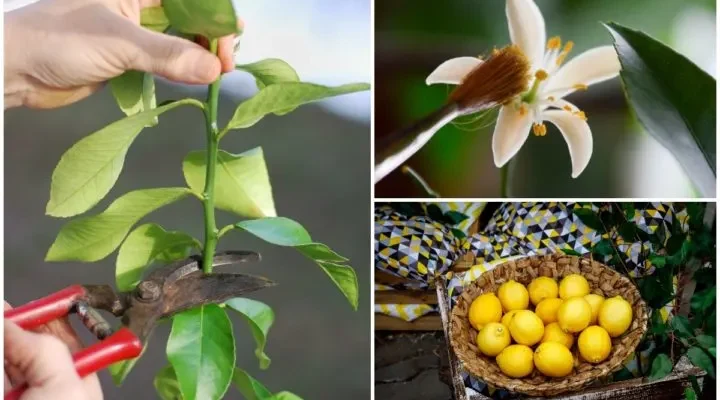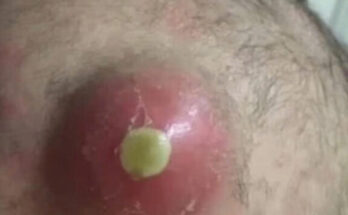Lemons are one of the most versatile fruits for cooking and baking, but did you know you can grow them at home?
While most citrus trees need to grow outdoors in warm, humid climates, the Meyer lemon tree will happily grow in a pot in your home.
We’ve been growing our own lemons indoors for years and are happy to share our best tips so you can do the same.
Why Grow Meyer Lemon Trees?
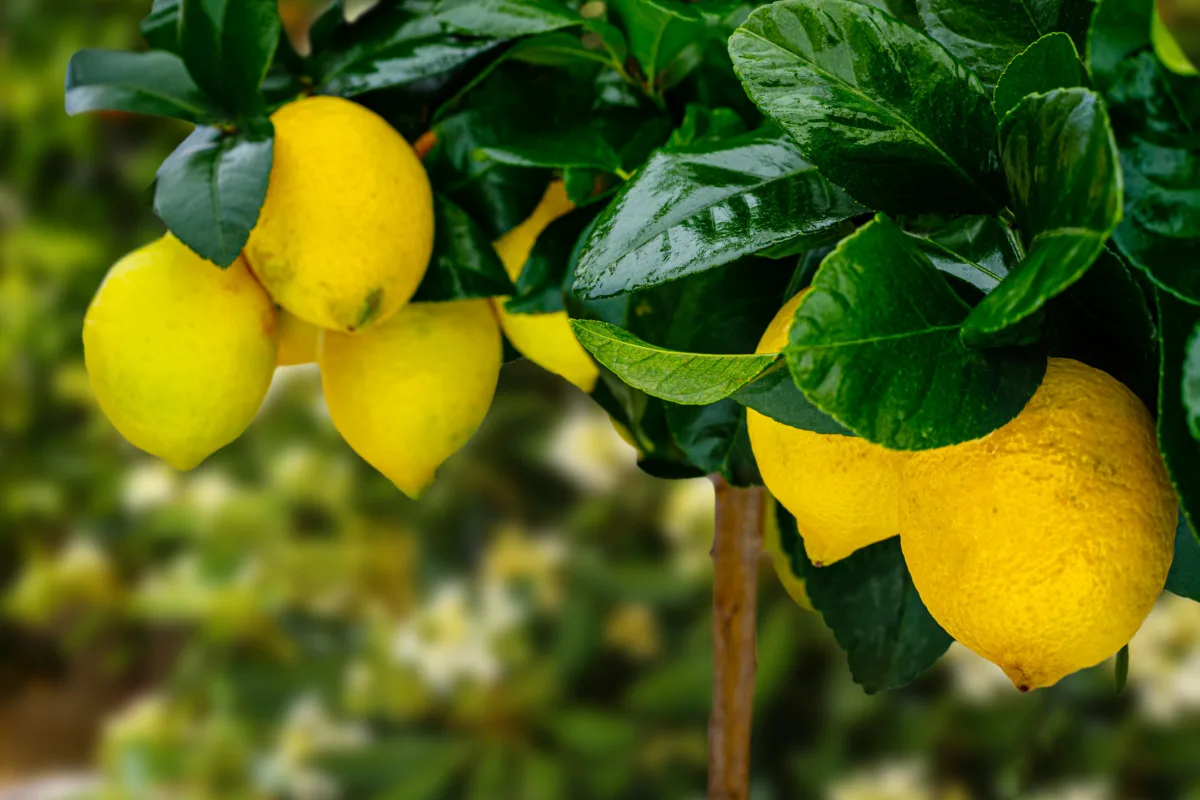
If you’ve never tasted a fresh Meyer lemon, you truly don’t know what you’re missing!
Meyer lemons are sweeter than average lemons and make the most amazing lemonade you’ve ever tasted. The reason you don’t see them for sale in grocery stores very often is that their soft skin makes it harder to ship them without damage.
But you don’t have to buy Meyer lemons when you can grow them. When grown in a pot this tree maxes out around 4 feet tall, which makes it easy to grow in your home.
Growing a Meyer lemon tree is easy as long as you have the right tools and knowledge going into it. This guide will show you all the basics of how to grow your own lemons at home.
Lemon Tree Buying Tips
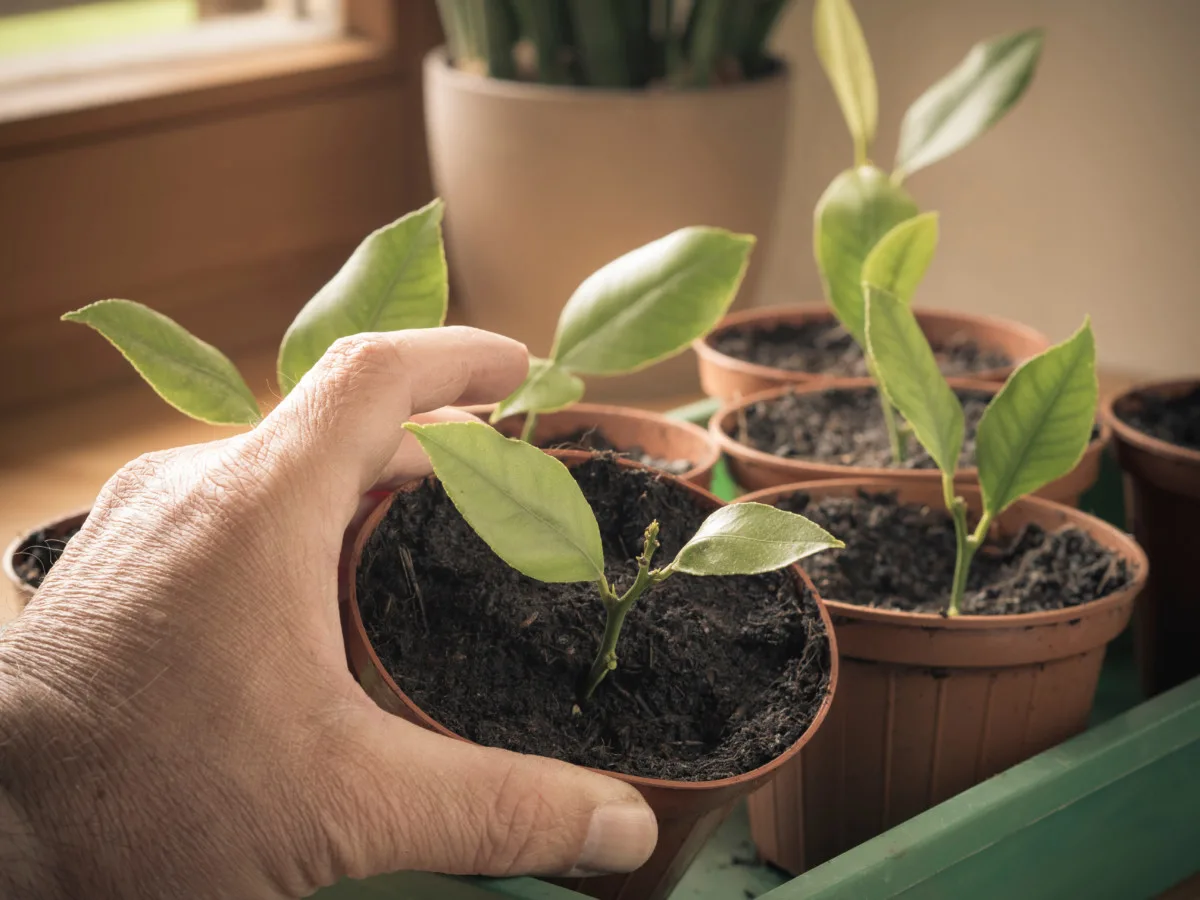
When buying your Meyer lemon tree, make sure you’re buying from a reputable nursery with lots of positive reviews. If possible, buy your tree from a local nursery so you can return it easily if there are issues. Buying locally also eliminates the stress of shipping the tree to your home.
If you can’t find a lemon tree locally, there are a lot of nurseries online but they’re not all created equal. We’ve bought many fruit trees online and only about a quarter of them have ended up being healthy and long-lasting. We have found Stark Bros to be a very reputable company that sells healthy trees.
It pays off to buy the biggest and oldest tree that you can afford and will fit in your home. Because it takes Meyer Lemon trees several years to produce fruit, buying an older tree will give you a major jump start on growing fruit. You might even get to harvest lemons in your first growing season!
The first lemon tree we bought was only a foot tall and it took many years before it started producing fruit. The second tree we bought was several years old already and was flowering on arrival. It was well worth the extra expense to save years of caring for a non-fruiting tree.
Light
One of the most important factors in growing a lemon tree indoors is providing proper light. Fruit trees love to soak up the sun, so whether you’re growing your tree indoors, outdoors, or a mix of both, you’ll need to make sure you’re providing enough light.
Indoor light
The very best place for a lemon tree to grow is outdoors, where it gets lots of sun. Most of us, unfortunately, don’t live in a region where we can grow lemon trees outside year-round, so we have to make do with an indoor arrangement. To give your lemon tree the best chance for success, place it in a south facing window so it gets bright light for the majority of the day.
We also hang a grow light over our lemon tree and use it every day to add supplemental light. If you want to make it easy on yourself, plug the grow light into an automatic timer so it will come on in the morning for a few hours and in the evening for a few hours.
We set our timer to turn the grow light on from 5 am to 8 am, then it shuts off during the day when the natural light is coming in and turns back on again from 5 pm to 8 pm. This system has worked well for us during very dark winters in Western New York, but you may need to adjust the timings for your own region and preferences.
Outdoor light
If possible, move your lemon tree outside when the weather is consistently staying above 50 degrees. No matter how grand your indoor plant setup is, it can’t compete with actual sunlight, fresh air, insect pollinators, and wind. The healthiest thing for your lemon tree is to spend at least a few months per year outdoors.
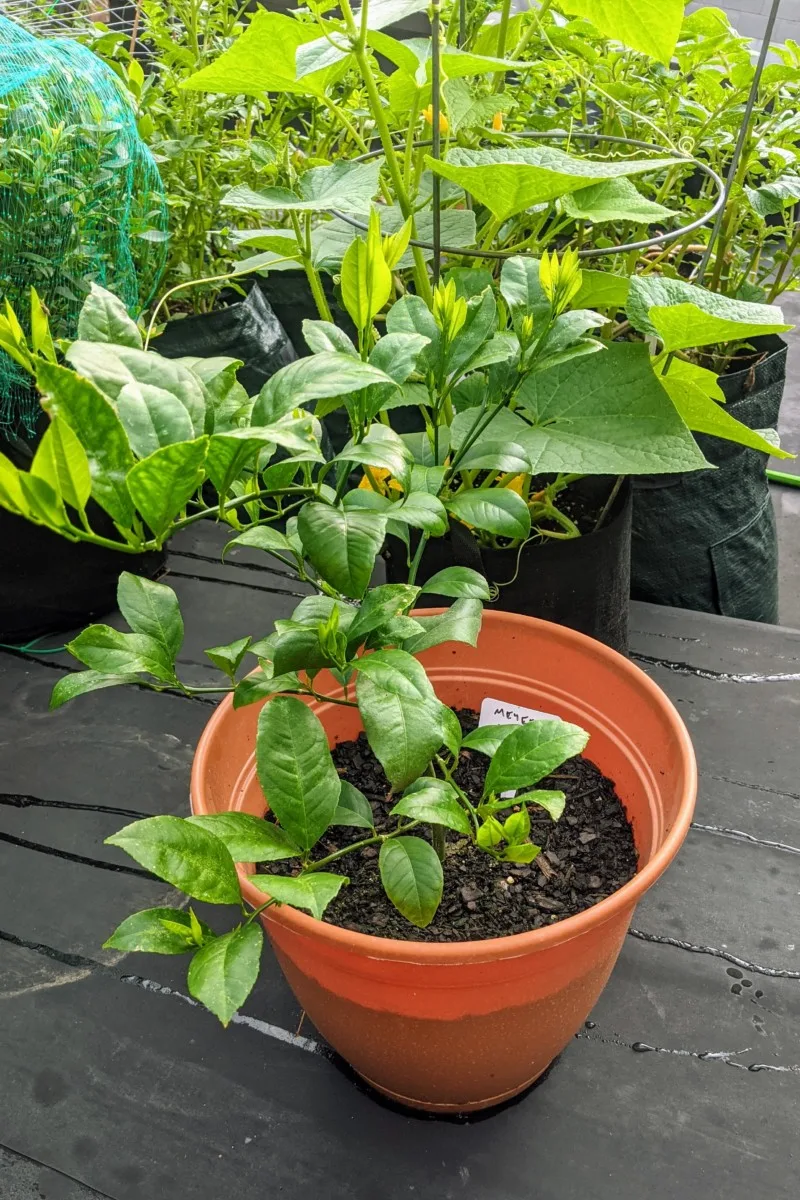
Lemon trees prefer full sun, eight hours per day is best but they can also survive in partial shade. Find the sunniest spot in your yard to park your lemon tree for the summer and it will be so happy!
When we move our lemon tree outside in the summer, we do so gradually. Since it’s spent many winter months indoors it needs to adjust to the new environment slowly. This hardening-off process ensures your tree won’t get stressed by the sudden change. Stressed lemon trees can lose a lot of leaves and attract nasty pests pretty quickly, so it pays off to go slow.
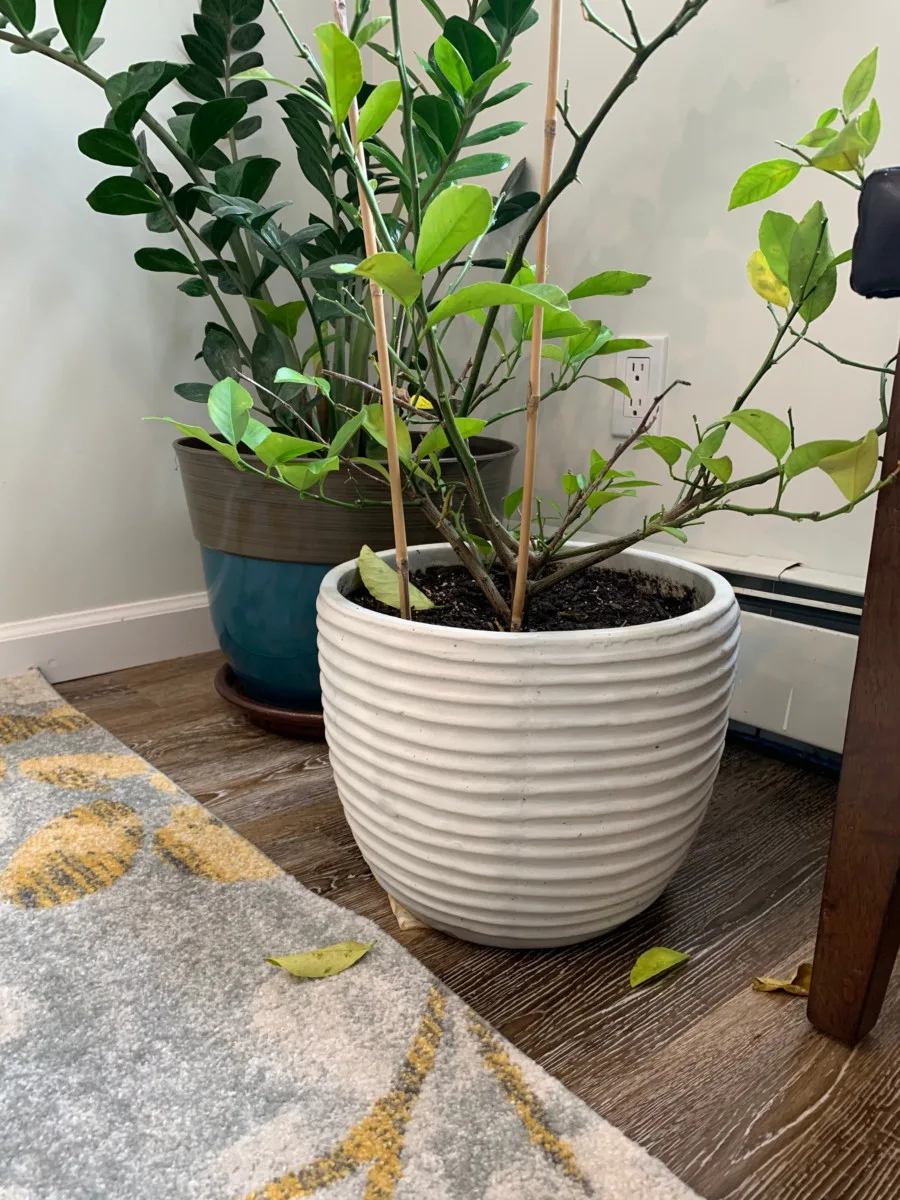
We like to start off by putting the tree in a shady part of the yard for the first week. Once the tree is acclimated to the shady spot, we move it to partial sun for half of the day and repeat that for another week. After that, you’re free to put your lemon tree in full sun (if you have it) full time.
Soil and Potting
Citrus trees purchased at nurseries usually need to be re-potted right away. The nursery should supply you with instructions for care, including how and when to re-pot the tree. In case they don’t, it’s generally a good idea to get the tree into a roomier pot during the first week. Most plants purchased from nurseries are root-bound and ready to size up.
To repot the plant, simply slide it out of its current pot, gently loosen the roots with your fingers so they can spread out a little bit, and plant it in a new pot that’s a little roomier than the current pot. Be sure that the pot you choose for your tree has drainage holes in the bottom, as Meyer lemon trees don’t like sitting in wet soil.
We usually re-pot our tree every summer, giving it a slightly bigger pot and fresh soil. This is also a good time to look for any root disease or insect pests and take care of them.
Citrus trees love light, loamy soil that drains really well. There are lots of great soils on the market specifically for citrus trees, and using that is generally your best bet for success. If you can’t find the right soil locally, you can mix regular potting soil with sphagnum peat moss to help it drain better.
Water
Watering a potted tree can be tricky. Overwatering will lead to root rot while underwatering can cause your tree to die from neglect. So how do you know how much is enough?
I use a very simple method of sticking my index finger into the soil up to the second knuckle. If the soil feels moist, I wait to water, if the soil feels dry, I water the tree thoroughly.
If you keep your lemon tree outdoors in the summer you’ll need to water much more frequently. During the hottest parts of summer, you may even need to water every day. Potted plants need a little more TLC than plants in the ground in the summer because they dry out more quickly and can’t dig deeper with their roots to find water, so they’re solely dependent on you to provide it.
Fertilizing
Citrus trees tend to be pretty heavy feeders, so you will definitely need to supplement your Meyer lemon tree with fertilizer several times per year. The soil in the pot just doesn’t supply enough nutrients for the tree to grow new leaves and fruit.
The best kind of fertilizer for lemon trees is one that is specifically formulated for citrus trees.
There are tons of different kinds on the market, from organic fertilizers to spikes that you stick in the soil, to foliar sprays that you put on the leaves. Use whichever kind of fertilizer appeals to your gardening style. The most important thing is that you remember to consistently apply it. Your fertilizer package will tell you exactly how much and how often to feed your tree.
When you apply fertilizer to a potted tree, place the fertilizer as close to the edge of the pot and away from the tree trunk as possible. You want to mimic the tree’s natural drip line.
We like to mark the calendar every time we do a feeding and plan ahead for the next one by putting that on the calendar too. That way the feeds are never forgotten and our lemon tree stays happy and fruiting.
Pollination
Meyer lemon trees tend to flower in the spring and in the fall, although if your lighting situation is a little wonky, they can flower at other times of the year too.
While a lot of fruit trees require two or more trees to get proper pollination, this isn’t the case with the Meyer lemon tree. Meyers are self-pollinating, which means the pollen in the flowers from a single tree can pollinate other flowers on that same tree. This is great news if you’re growing your lemon tree indoors because you don’t need to find space for two trees.
If you’re keeping your lemon tree outside when they flower, you shouldn’t need to worry about pollination. The insects and the wind will make it happen. However, if you’re keeping your lemon tree indoors at all times, you’re going to need to do a little extra work.
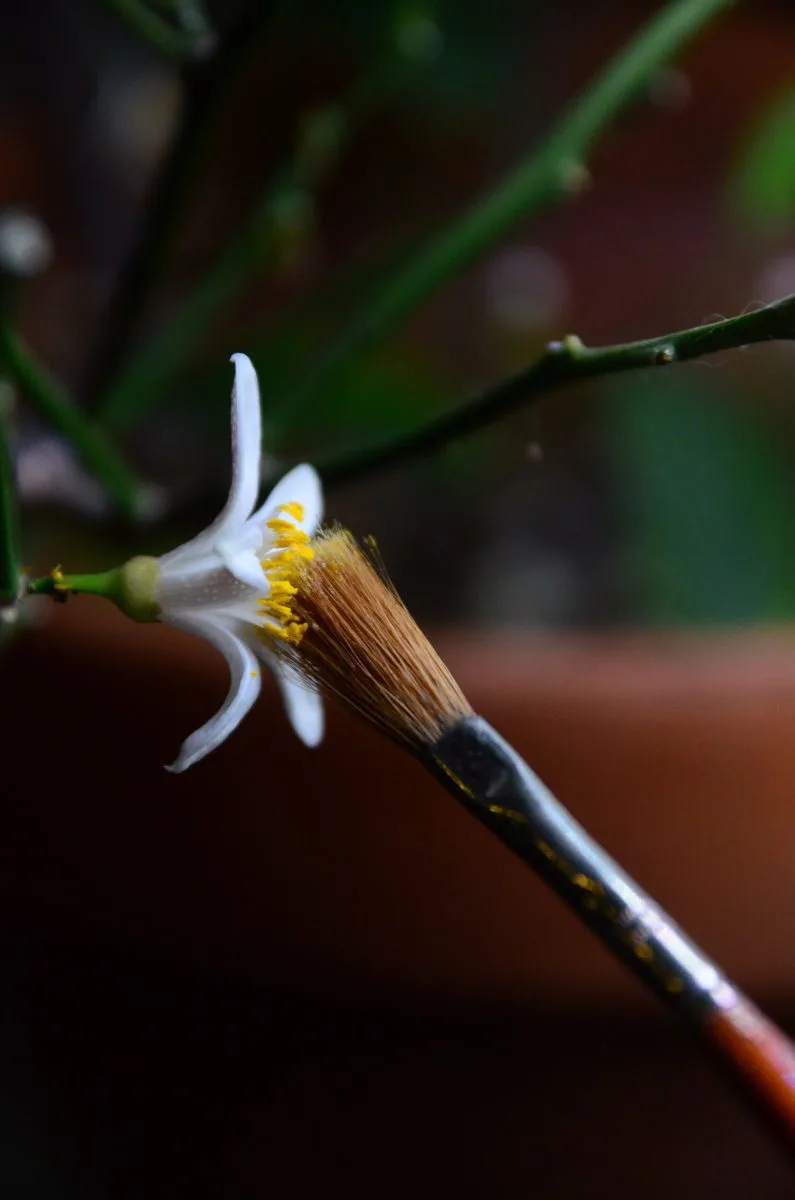
Indoor lemon trees may need to be hand-pollinated when they bloom. In my experience, the flowers that don’t get hand-pollinated don’t produce fruit. Thankfully, pollination is easy enough to do by hand.
Use a paintbrush, makeup brush, or q-tip to gently rub the inside of a flower, the goal is to get lots of yellow pollen on the brush. Then use that same brush to rub the inside of another flower, making sure to transfer some of that pollen to the bulbous stigma in the center of the flower. Repeat the process for all open flowers on the tree. If the flowers are ready for pollination the stigma will be sticky and will accept the pollen easily.
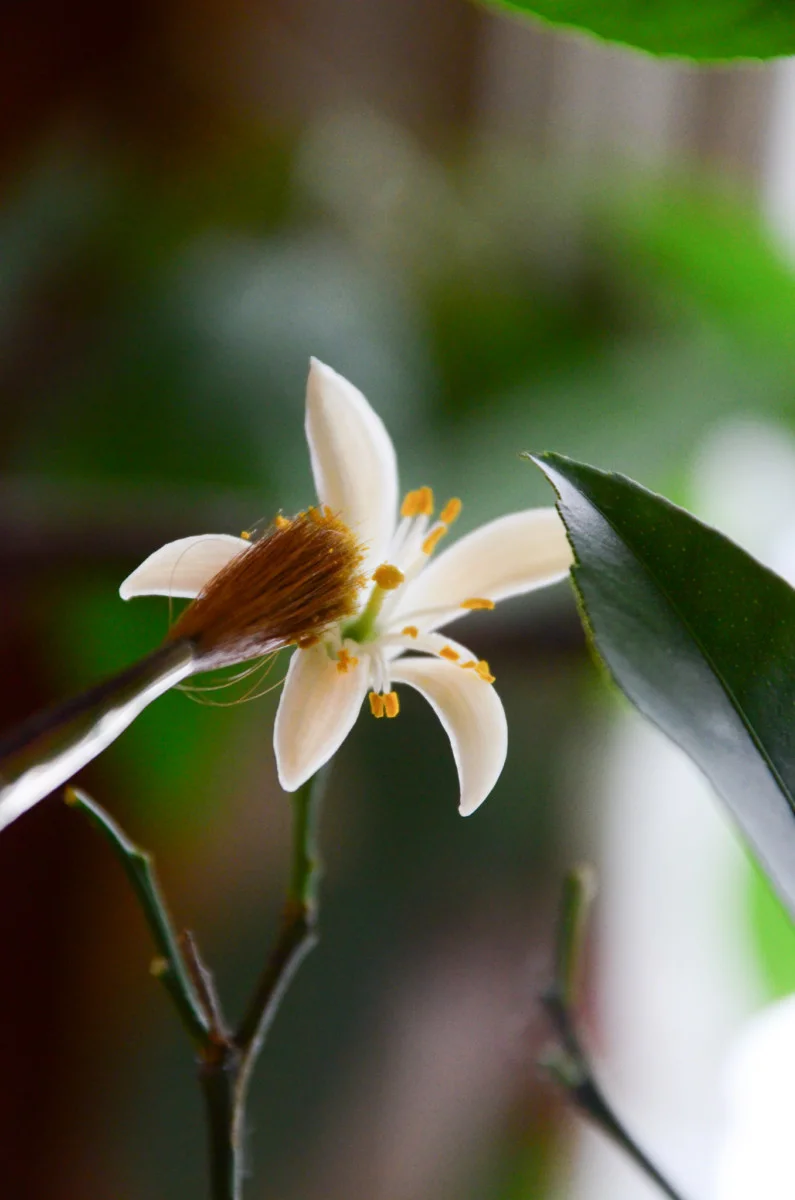
An alternative way to hand pollinate is to pick a flower from the tree and rub it gently on the other flowers.
It’s impossible to know outright which flowers will yield fruit, but to give yourself the best chance of success, repeat this process every few days for as long as you have open blooms on the tree.
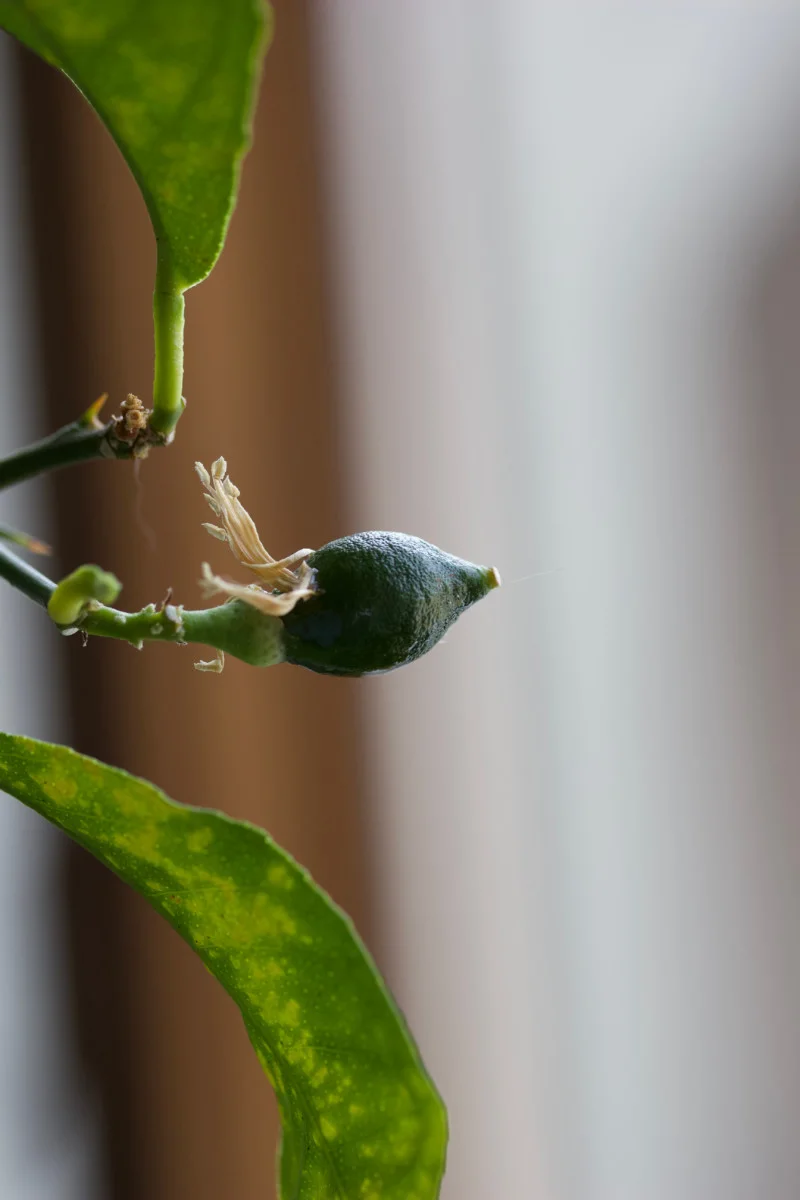
Pruning
Just because you are growing a petite lemon tree indoors doesn’t mean you get out of pruning it. It’s more important to prune a Meyer lemon that spends most of its life inside, as you will want to create a compact shape.
Pruning a fruit tree isn’t as difficult as one would imagine; in reality, you will always be making only two different cuts – heading and thinning.
Heading cuts promote new growth.
A heading cut is when you cut off a section of a branch, but you’re still leaving a portion of it. For example, you may only cut half of a branch off or two-thirds of it. Because you have left a portion of the branch in tact, there will still be leaves and nodes signaling to the tree that growth is occurring on that branch. The tree will put energy into growing new branches at the site of the cut.
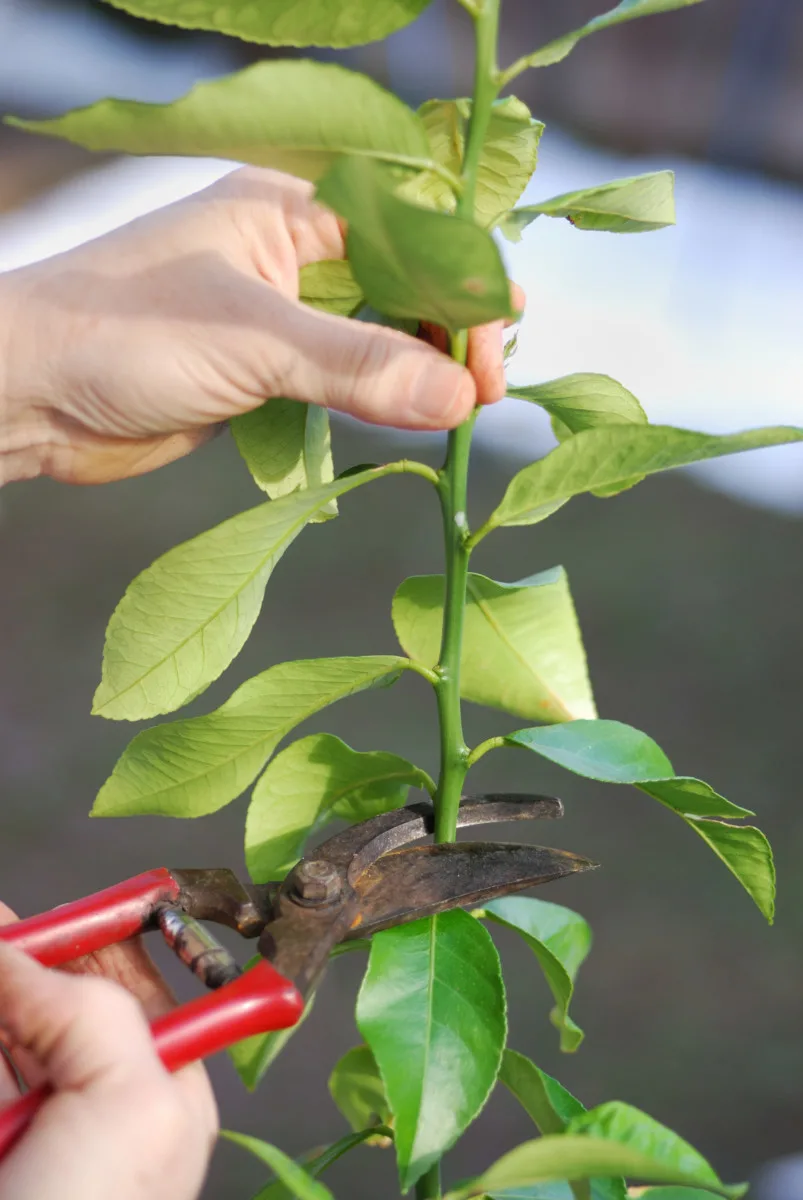
Heading cuts encourage prolific growth. If one side of your tree isn’t as full as the other, do a heading cut or two on branches in the thinner area. It seems counterintuitive, but this will signal to the tree to grow branches on those heading cuts, and that side of the tree will fill out.
Thinning cuts fully remove oddly shaped branches, branches that are too long, or branches that may be in the way.
With a thinning cut, you’re removing the entire branch. You’ll make the cut at the base of the branch where it meets up with the larger limb or even the trunk where it’s growing.
Because there are no nodes left to signal to the tree to continue to grow, no new growth will occur where the branch was removed.
When pruning your Meyer, it’s important to remember you can take off up to a third of the tree at a time. Give your tree at least six months to recover between major trim jobs. However, a branch or two here and there is fine.
Common Meyer Lemon Pests & Diseases
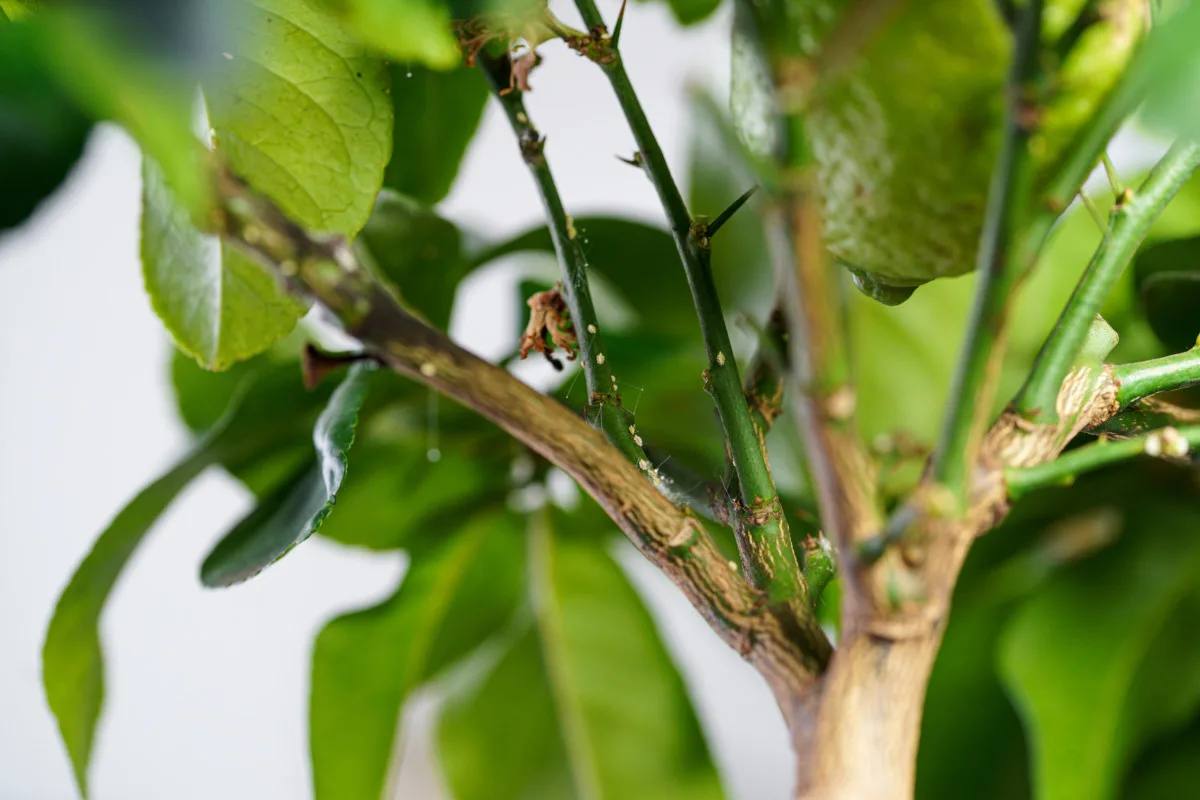
The great thing about growing a Meyer lemon tree indoors is avoiding many of the more serious diseases and pests that plague citrus. But there are still a few to watch out for.
Spider Mites
One of the most common pests that affect indoor citrus is spider mites. You most likely won’t be able to see the mites, but you will be able to see their presence. The first sign is often leaves with tiny yellow stippling all over them. A closer look will reveal fine webbing on the leaves and branches. Tracey has a helpful guide on how to deal with spider mites.
Spider mites prefer dry environments, so one of the easiest things you can do to prevent an infestation is to mist your lemon tree frequently. You may want to mist it daily during the dry winter months.
Scale
Another common pest among indoor citrus is scale. You may notice brown, waxy bumps on the stems of your Meyer lemon or even a shiny, sticky substance on the leaves and area around your tree. Scale can be a pain to get rid of and requires immediate attention and quarantining of your plant. Again, Tracey can give you the full details on how to get rid of scale on your lemon tree.
Root Rot
A fungus causes root rot, and it’s most likely one of the only diseases your indoor citrus plant may have to deal with. Root rot is caused by overwatering your plants and using containers that don’t have drainage holes. This allows a fungus to infect the root system. Left untreated, root rot can quickly kill a plant. Learn everything you need to know to treat and prevent root rot.
Harvesting Fruit
One of the only tough things about growing Meyer lemon trees indoors is waiting for the fruit to ripen so you can eat it. Unlike some types of fruit, you need to wait until the Meyer lemon fruit is completely ripe on the tree before harvesting it. If you’re exclusively growing the tree indoors, this can take six months, or even up to a whole year for the fruit to ripen. Trees that are grown outdoors for some of the year will ripen more quickly.
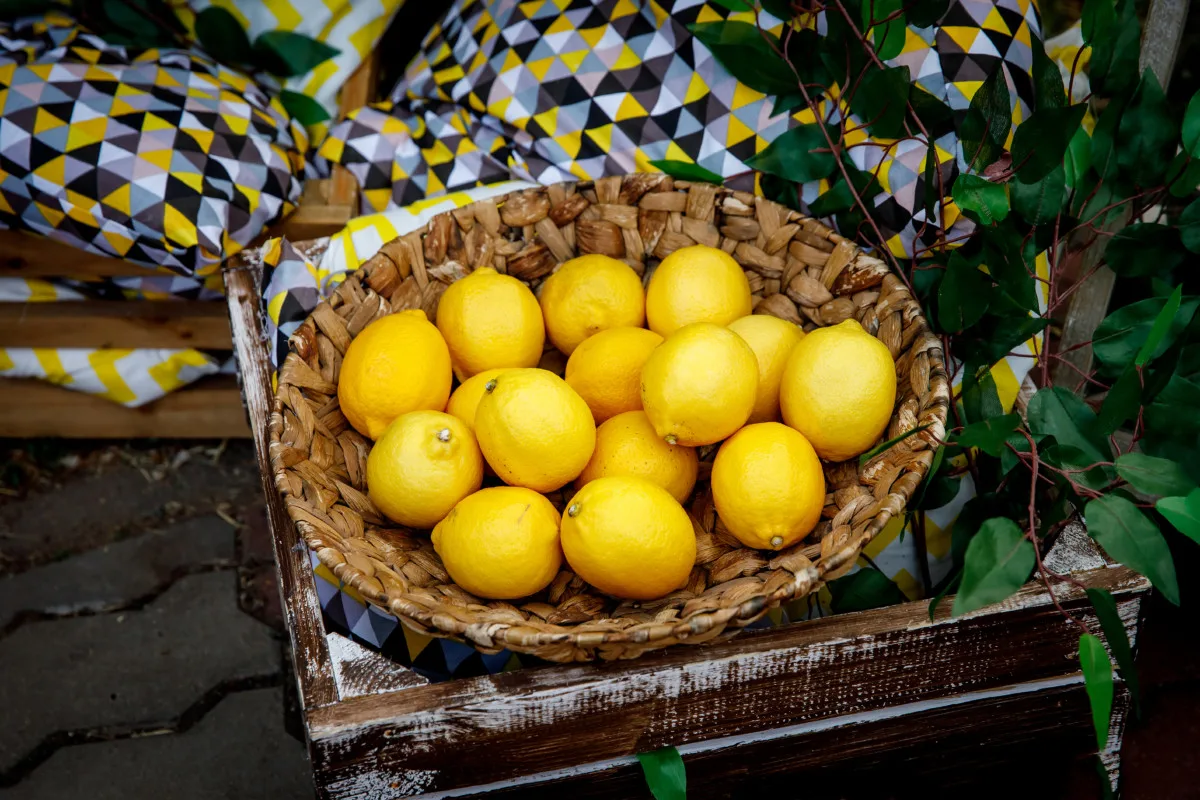
When your lemons are bright yellow and slightly soft to the touch, they’re ready to cut off the tree and enjoy. You can use Meyer lemons the same way as any other type of lemon, but our favorite way is to make them into lemonade.
Now that you know how to care for a Meyer lemon tree, beware, because before you know it, you’ll be moving on to all sorts of other fruit trees. You would be amazed at the variety of fruit trees you can grow indoors.
We love to tell people that our Meyer lemon tree is at fault for the ever-growing orchard in our backyard. Growing fruit is so rewarding, that it’s hard to stop. Even if you don’t have a lot of outdoor space, there’s a fruit tree for you.
